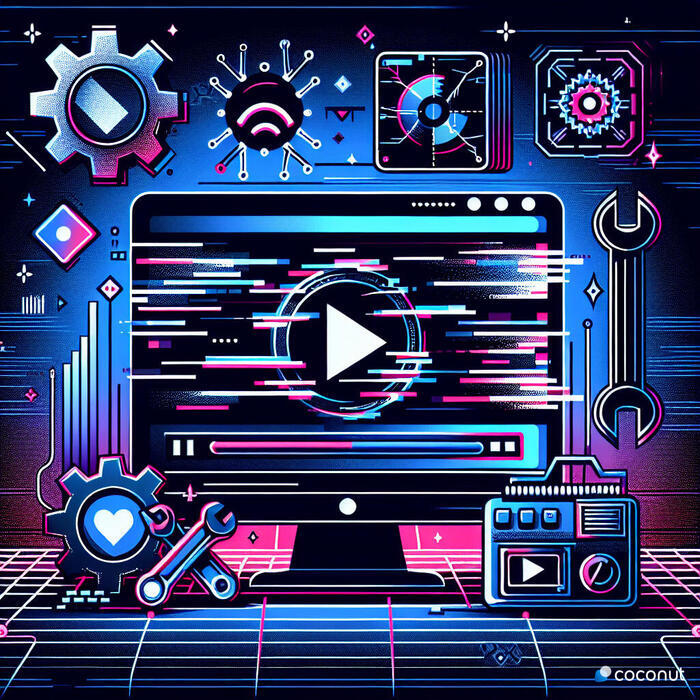Hey there, glad you found us! We're going to be exploring the world of video playback issues - a topic that many find daunting, but we promise to make it as simple as pie. Why does this matter, you ask? Well, in our increasingly digital world, video content is king. But what happens when the king is dethroned by playback issues? Frustration ensues, viewership plummets, and messages get lost in the static. This article will be your trusty guide to navigating these choppy waters. Let's get started, shall we?

Unraveling the Mystery: Common Causes of Video Playback Issues
The Codec Conundrum
Ever heard of a codec? If you're scratching your head, don't worry, you're not alone. Codec is short for 'coder-decoder'. It's a little piece of software that compresses a video file so it can be stored or transmitted, then decompresses it for playback. Now, imagine trying to open a file without the right software. Frustrating, right? That's exactly what happens when there's a codec incompatibility. Your video might stutter, lag, or not play at all. It's like trying to fit a square peg into a round hole. The good news? There are tools out there to help you identify which codec your file needs. Once you know that, it's just a matter of downloading the right one.
The Driver Dilemma
Think of drivers like the conductors of your computer's orchestra, coordinating all the different parts so they work in harmony. When they're up to date, everything runs smoothly. But when they're outdated? Well, that's when you might start experiencing video playback issues. It's like trying to conduct a symphony with a broken baton. You might see pixelated images, hear distorted audio, or your video might not play at all. But don't fret, updating your drivers is usually as simple as clicking a button. Just remember to do it regularly, like brushing your teeth or feeding your goldfish.
The Bandwidth Bottleneck
Imagine trying to squeeze a watermelon through a garden hose. Not going to happen, right? That's what it's like trying to stream high-quality video on a slow internet connection. Your bandwidth - the amount of data your internet connection can handle at once - is just too narrow. You might experience buffering, lagging, or a drop in video quality. So how do you fix it? It could be as simple as closing a few browser tabs or as complex as upgrading your internet plan. Either way, it's worth investigating if you want to avoid the dreaded spinning wheel of doom.
The Browser or App Annoyance
Ever tried to open a stubborn jar lid? You twist and turn, but it just won't budge. Sometimes, browsers and video apps can be just as stubborn. A bug, a glitch, or a cache overflowing with data can all cause video playback issues. But don't worry, you won't need a jar opener for this one. Clearing your cache, updating your software, or switching to a different browser can often do the trick. It's like greasing the lid of that stubborn jar - suddenly, everything works smoothly.
The Hardware Hurdle
Have you ever tried to run a marathon without training? It's pretty tough, right? Well, that's what it's like for your computer when it's trying to play high-quality video with inadequate hardware. It just can't keep up. You might experience lagging, buffering, or a drop in video quality. But don't despair, there are solutions. Upgrading your hardware, like adding more RAM or a better graphics card, can help. It's like giving your computer a pair of running shoes and a personal trainer - suddenly, that marathon doesn't seem so daunting.
Demystifying Video Playback Issues: A Comprehensive Guide
Ever found yourself in the middle of an intense movie scene, only to be interrupted by a buffering icon? Or perhaps you've experienced the frustration of a video file refusing to play? We've all been there, and we understand how annoying it can be. But don't worry, we've got you covered. Let's dive into the world of video playback issues and explore how to solve them.

Hardware Limitations and Video Playback
Let's start with a simple truth: not all hardware is created equal. If you've ever tried to run a modern video game on an older computer, you'll know exactly what we mean. It's like trying to squeeze a square peg into a round hole - it just doesn't work. The same principle applies to video playback. Older or less powerful hardware can struggle to keep up with the demands of high-resolution, high-frame-rate video content.
So, what can you do about it? Well, there are a few things. First, you can try reducing the quality of the video. This may not be ideal, but it can help to make the video more playable. Second, you can close any unnecessary applications that are running in the background. These applications can eat up valuable system resources, leaving less for your video playback. Finally, if all else fails, it might be time to consider upgrading your hardware. It's like trading in your old bicycle for a shiny new sports car - it can make a world of difference.
File Corruption
Imagine you're trying to read a book, but some of the pages are torn or missing. It would be pretty hard to follow the story, right? This is essentially what happens when a video file becomes corrupted. Bits of data are lost or damaged, making it impossible for your media player to interpret the file correctly. This can result in a range of issues, from minor glitches and freezes to complete playback failure.
So how can you tell if a file is corrupted? Well, the most obvious sign is if the file won't play at all, or if it plays but with noticeable issues. There are also tools available that can analyze your files and detect any corruption. If you do have a corrupted file, don't panic. There are plenty of software tools out there that can help to repair it. It's like having a mechanic for your digital files - they can help to get them running smoothly again.
Solutions to Video Playback Issues
Now that we've covered the basics, let's get down to the nitty-gritty. We're going to walk you through some common solutions to video playback issues, step by step. Ready? Let's go.
Updating Codecs
Think of codecs like translators. They take the raw data from your video file and translate it into images and sounds that your media player can understand. If your codecs are out of date or missing, your media player may struggle to interpret your video files correctly. The good news is, updating or installing codecs is usually a pretty straightforward process.

First, you'll need to find out which codecs your video file requires. This information is often included in the file's properties. Once you know which codecs you need, you can download and install them from a trusted source. After the installation is complete, restart your media player and try playing the video again. With a bit of luck, you'll be back in business.
Updating Drivers
Drivers are another important piece of the puzzle. They act like a middleman, facilitating communication between your hardware and your software. If your drivers are out of date, this communication can break down, leading to video playback issues.
Updating drivers can vary depending on your operating system, but generally, it involves going into your system settings, finding the relevant hardware (such as your graphics card), and checking for updates. If an update is available, you'll need to download and install it. Once the update is complete, restart your computer and try playing the video again. Hopefully, you'll notice an improvement.
Optimizing Internet Connection
Let's face it, we live in a world where a fast and stable internet connection is crucial. Whether we're streaming movies, video calling with friends, or just browsing the web, we rely on our internet connection to keep us connected. If your internet connection is slow or unstable, it can lead to video buffering or even playback failure.
There are several ways to improve your internet speed. First, consider using a wired connection instead of Wi-Fi. Wired connections are generally faster and more stable. Second, try changing your DNS settings. This can often lead to a noticeable improvement in speed. Finally, consider the placement of your Wi-Fi router. It should be in a central location, free from obstructions. Give these tips a try and see if they help to improve your video playback.
Browser and App Maintenance
Just like a car needs regular maintenance to keep it running smoothly, so too do your browser and apps. Over time, they can become cluttered with unnecessary data, which can slow them down and cause issues with video playback.

The first step in maintaining your browser and apps is to clear your cache. This is like taking out the trash - it gets rid of all the junk that's been piling up. Next, consider disabling any unnecessary extensions. These can eat up system resources and slow down your browser. Finally, make sure your browser and apps are up to date. Developers regularly release updates to fix bugs and improve performance, so it's important to stay on top of these.
Hardware Upgrades
As we mentioned earlier, sometimes the best solution is to upgrade your hardware. This can be a big decision, and it's not one to be taken lightly. Upgrading your hardware is like getting a heart transplant - it's a major operation, but it can give you a new lease on life.
When considering a hardware upgrade, it's important to identify the bottleneck in your system. This could be your graphics card, your RAM, or even your entire system. Once you've identified the bottleneck, you can look at options for upgrading. This could involve buying a new graphics card, adding more RAM, or even buying a whole new computer. It's a big step, but it can make a huge difference to your video playback capabilities.
Repairing Corrupted Files
Finally, let's talk about repairing corrupted files. As we mentioned earlier, file corruption can cause all sorts of video playback issues. Luckily, there are plenty of tools out there that can help to repair these files.
First, you'll need to download a file repair tool from a trusted source. Once you've downloaded and installed the tool, you can use it to scan your corrupted file. The tool will analyze the file and attempt to repair any corruption. This process can take some time, so be patient. Once the repair is complete, try playing the video again. With a bit of luck, your video will be back in action.
Preventative Measures
They say that prevention is better than cure, and we couldn't agree more. By taking some simple preventative measures, you can help to avoid video playback issues in the first place.

Regular Maintenance
First and foremost, make sure to keep your system well-maintained. This includes keeping your software up to date, regularly clearing your cache, and running regular scans for malware. It's like taking your car in for regular oil changes - it helps to keep everything running smoothly.
Second, be mindful of your internet connection. Try to ensure a stable and fast connection, as this can make a big difference to video streaming. Finally, take care of your files. Avoid downloading files from untrusted sources, as these can often be corrupted. By following these simple tips, you can help to keep your video playback smooth and trouble-free.
So there you have it - a comprehensive guide to solving video playback issues. We hope you've found this guide helpful, and that you're now better equipped to tackle any video playback issues that come your way. Remember, if all else fails, don't be afraid to ask for help. There's a whole community of tech-savvy people out there who are ready and willing to lend a hand. Happy viewing!
Let's talk about system maintenance. It's like a regular health check-up for your computer. You know how you visit a doctor for a routine check-up to ensure everything is running smoothly? That's exactly what system maintenance is for your computer. It includes updating your software, checking your hardware, and getting rid of those pesky, unnecessary files that are just taking up space. Think of it as a spring cleaning, but for your computer, and it's something you need to do regularly, not just once a year.
Choosing the Right Software
Now, let's move on to the topic of video playback software. Imagine you're trying to watch your favorite movie, but the video keeps lagging or the quality is poor. Frustrating, right? That's why it's crucial to choose reliable video playback software. But it's not just about picking the right one, it's also about keeping it updated. Think of it like keeping your car in top shape. You wouldn't ignore a strange noise coming from your engine, would you? Similarly, you shouldn't ignore software updates. They're there to fix bugs and improve performance, ensuring your video playback experience is smooth and enjoyable.
Backup and Redundancy
Next up, let's discuss backups and redundancy. Imagine you've spent hours editing a video, only for your computer to crash and lose all your work. It's a nightmare scenario, right? That's where backups come in. They're like your safety net, ensuring your hard work doesn't go to waste. And then there's redundancy. It's like having a spare tire in your car. If one system fails, the other can take over, preventing data loss and playback interruptions. So, don't underestimate the importance of backups and redundancy. They could save you a lot of time and frustration in the long run.

Real-Life Scenarios and Solutions
You might be wondering, "How does all this apply to me?" Well, let's consider a few real-life scenarios. Imagine you're a filmmaker, and you've just finished editing your latest project. You're excited to share it with the world, but when you try to play it back, the video keeps freezing. Frustrating, right? But with the right software and regular system maintenance, you could avoid such issues. Or maybe you're a teacher, trying to show a video in class, but it won't play. Again, with the right tools and maintenance, you can ensure your lessons go smoothly. These are just a few examples, but they show how these solutions can apply to various situations.
Frequently Asked Questions
Now, let's address some common questions. "Why does my video keep buffering?" This could be due to outdated software or a slow internet connection. "Why can't I play certain video formats?" Again, this could be a software issue. Your video player might not support the format. "How can I prevent data loss?" Regular backups and redundancy can help with this. These are just a few examples, but they show that many common issues can be resolved with the right knowledge and tools.
So, what have we learned? System maintenance is crucial, much like a regular health check-up for your computer. Choosing the right video playback software and keeping it updated can greatly improve your viewing experience. Backups and redundancy can save you a lot of time and frustration, acting as a safety net for your data. And finally, there are numerous resources available online to help you further your knowledge and resolve any issues you might encounter. So, don't hesitate to implement these solutions and improve your video playback experience. And remember, we're always here to help. If you have any questions or experiences to share, feel free to leave a comment below.





